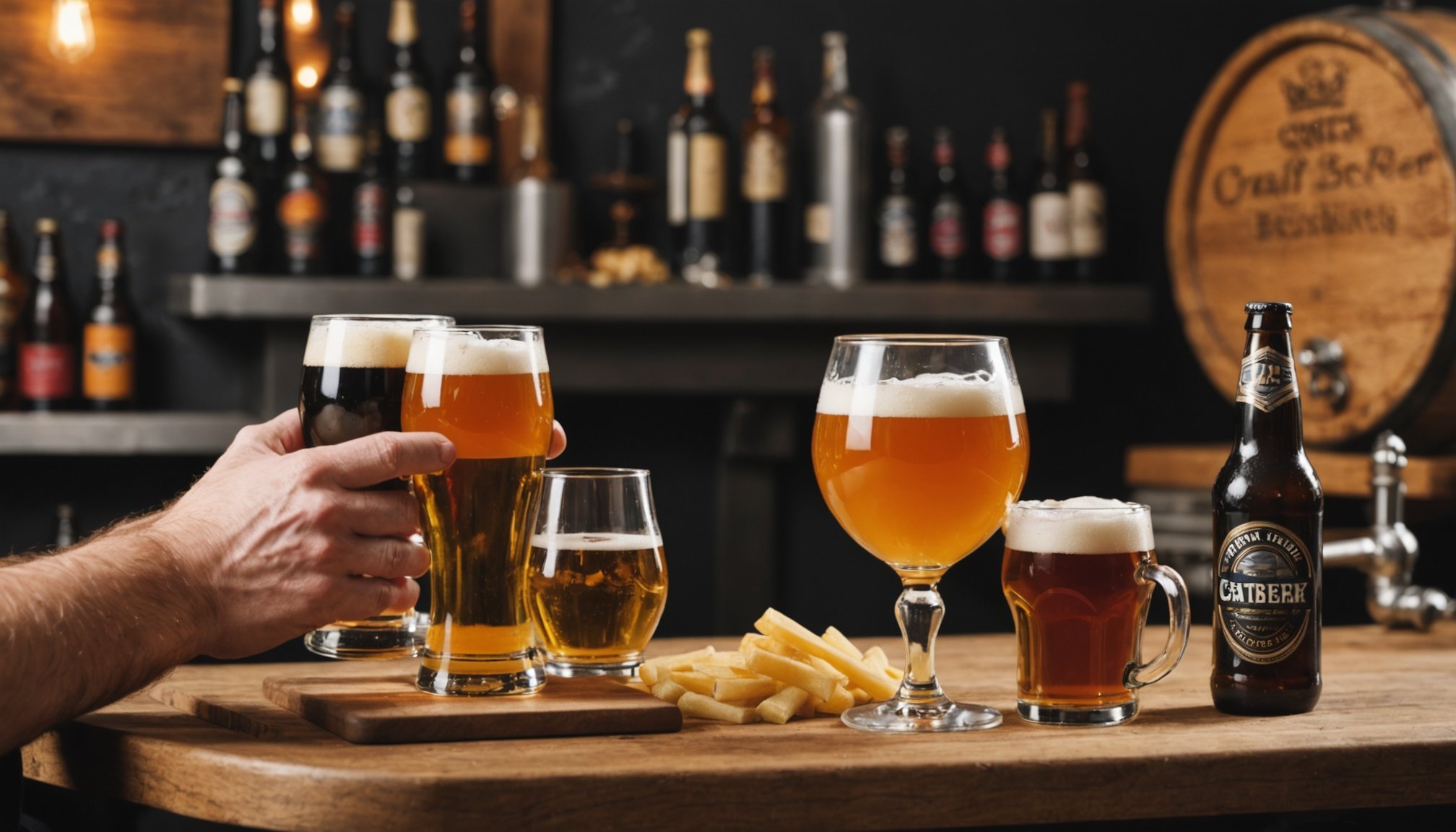Understanding Customer Loyalty in the Craft Beer Market
Customer loyalty in the craft beer industry is integral to brand success, particularly in the dynamic UK market. This loyalty is characterized by repeat purchases and emotional connections that consumers form with specific brands. In a market saturated with numerous options, establishing a loyal customer base can significantly boost sales and brand credibility.
In the UK, consumer behavior often leans towards seeking novelty and unique experiences, an insight pivotal for crafting effective marketing strategies. Breweries can tap into this by offering distinctive flavors or limited-edition brews to capture the adventurous spirit of the craft beer aficionado. Understanding these preferences is crucial for brewers aiming to retain customers long-term.
Also to discover : Unlocking interactive growth: innovative social media challenge strategies for uk dance studios
Current trends driving loyalty in the craft beer sector include a strong preference for locally sourced ingredients and sustainable brewing practices. Consumers are increasingly valuing transparency and ethical production, influencing their loyalty towards brands that align with these ideals. Craft breweries can thus differentiate themselves by emphasizing these factors in their marketing efforts.
A tailored approach focused on meeting specific consumer expectations and highlighting brand values can forge stronger emotional connections. These connections are essential for sustaining customer loyalty in a competitive market, reinforcing the importance of strategic marketing strategies in the UK market.
Additional reading : Unlocking interactive growth: innovative social media challenge strategies for uk dance studios
Proven Email Marketing Tactics for Craft Breweries
Understanding effective email marketing strategies can greatly enhance the success of craft breweries. One key tactic is the use of personalization and audience segmentation. By tailoring your content to different customer segments, you address specific interests, thereby increasing engagement. For instance, a craft brewery could segment its audience based on preferred flavours, allowing tailored newsletters showcasing new brews that might appeal to each group.
Successful tactics also revolve around timing and frequency. Sending emails at consistent and strategic times ensures that your messages remain relevant and anticipated. Finding the ideal frequency requires balance; too frequent, and you risk coming across as spam, too sparse, and you might be forgotten. A successful campaign might involve sending newsletters weekly or bi-weekly based on customer response and interaction metrics.
Engagement can also be boosted by including interactive content such as polls or feedback requests in your emails. This not only keeps your audience interested but also allows for a deeper understanding of their preferences. By implementing these proven tactics, craft breweries can see a notable increase in customer interaction and loyalty, ultimately fostering a thriving community around their brand.
Always remember, the key lies in relevancy and authenticity when engaging with your audience through email marketing.
Real-Life Case Studies of Successful Email Campaigns
Studying real-life case studies can provide meaningful insights into how successful email campaigns operate, revealing strategies that drive success.
Case Study 1: [Brewery Name]
In this first case study, we delve into a craft beer brewery’s efforts to enhance customer loyalty. Faced with the challenge of stiff competition and a crowded market, their objectives were clear: increase engagement and build lasting relationships with customers.
To tackle these challenges, the brewery devised a strategy leveraging personalised content and targeted messaging. Their email campaigns featured stories about the brewery’s journey, inviting subscribers to engage with the brand’s heritage and values. Unique promotions and event invitations were also incorporated, fostering a sense of inclusion and community.
The impact of these tactics was significant. Customer loyalty was visibly strengthened, illustrated by boosted event participation and a marked increase in repeat purchases. The brewery learned the value of authenticity in communication and the importance of making their customers feel valued and connected.
Case Study 2: [Brewery Name]
A different craft beer brewery set out to adapt its email marketing strategies to meet evolving market demands and attract a broader audience. Their campaign focused on educating consumers about the nuances of craft beer, aiming to broaden their customer base while maintaining engagement with existing clientele.
Utilising engaging newsletters and eye-catching visuals, the campaign managed to attract new consumers. Metrics revealed a notable uptick in newsletter subscriptions and online sales, highlighting the effectiveness of their innovative and customer-centric approach.
Creating Engaging Email Content
In the world of craft beer, captivating email content is key to enhancing customer engagement. The journey begins with eye-catching email design, where the use of vibrant visuals and colour palettes that reflect your brand’s personality can make a substantial impact. For craft beer enthusiasts, imagery that showcases brewing processes or high-quality product shots of beers can be particularly engaging.
Effective storytelling is crucial in conveying compelling brand messaging. Sharing the story behind your latest brew or highlighting the traditional methods used in your brewing process can create a deeper connection with customers. Intertwining fascinating narratives with the history or the origins of your ingredients can make readers feel part of something bigger.
Additionally, an irresistible call-to-action (CTA) is a must. A well-crafted phrase like “Discover Your Next Favourite Brew” or “Uncover the Craft” can encourage clicks and further customer engagement. Consider using action-oriented language to inspire immediate responses.
To capture your audience’s attention, balance informative content with intriguing elements. High-quality images, personable narratives, and creative CTAs fuse to form a engaging email content strategy that not only captures interest but also fosters loyalty within the craft beer community. These elements together form a successful blueprint for meaningful customer contact.
Best Practices for Maintaining Customer Engagement through Email
Fostering effective customer engagement through email begins with understanding and utilizing best practices in email marketing. By implementing refined strategies, businesses can nurture and sustain robust customer relationships. Firstly, tailor your communications with personalized content; this can significantly increase open rates and foster deeper connections.
To strengthen these relationships, feedback loops are invaluable. Engage customers with surveys and encourage them to share their experiences. This will provide insights into their preferences and satisfaction levels, allowing you to refine your engagement tactics accordingly. Such feedback not only aids in meeting customer expectations but can also guide future campaigns to enhance relevance and efficiency.
Incentivizing repeat purchases is another critical aspect of maintaining engagement. Offering exclusive deals or tailored promotions encourages ongoing interaction. Consider featuring these incentives prominently in your emails, making it easy for customers to take advantage of them.
For example, introducing a loyalty programme via email can motivate continued patronage. Highlight benefits clearly, such as discounts or early access to new products.
Effective email marketing also requires a consistent schedule without overwhelming the subscriber; striking a balance is key. Regularly updating your content and offers will keep your audience engaged while respecting their time and inbox space.
Measuring Success and Adjusting Strategies
In the dynamic world of email marketing, accurately tracking key performance indicators is crucial. Success metrics such as open rates, click-through rates, and conversion rates provide insights into the effectiveness of campaigns. These metrics need to be regularly reviewed to ensure marketing efforts are aligned with business goals. Advanced email marketing analytics tools, like Mailchimp or Constant Contact, offer detailed reports and visualizations that help marketers measure their success.
For craft beer businesses, leveraging these tools can enhance visibility into customer engagement levels, allowing for strategy adjustment. By analyzing which types of content resonate most with the audience—be it promotional offers or stories about new brews—marketers can better tailor their approach.
Adjusting strategies based on data analysis is not a one-off task. It’s essential to iterate and refine tactics continually. This iterative process should also involve customer feedback to understand their evolving preferences. Acting on this feedback can lead to more personalized email content, driving higher engagement.
Ultimately, regularly monitoring success metrics and adapting based on the insights gained ensures that email marketing remains a powerful tool for reaching and connecting with customers in the craft beer industry.











